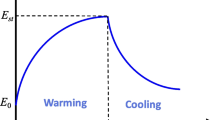Abstract
Ram–Quill combination spindle has been applied widely in horizontal boring milling machine. It is a great benefit that the machine can be used for various applications. But as the report of experiment, the ram housing bent when it is moved for more than half of its maximum travel. The straightness of Ram housing is out of the tolerance and the runout of the spindle is way behind the requirement when spindle is at the maximum extension point. This paper proposes an electro-hydraulic monitoring and compensation system which will be able to adjust the pressure to the compensation mechanism in time. The experiments prove that the straightness of horizontal surface can meet the requirement, and a ball bar test at the extremely weak point shows an improvement of the roundness tolerance for 65.8 %. This can improve the tolerance of the machine, becoming a superior device.
Similar content being viewed by others
References
Wang M, Fei RY (2001) On-line chatter detection and control in boring based on an electrorheological fluid. Mechatronics 11:779–792
Senbabaoglu F, Lazoglu I, SO (2010) Experimental analysis of boring process on automotive engine cylinders. Int J Adv Manuf Technol 48:11–21
Kong LF, Li Y, Lu YJ, Li DX (2009) Complex nonlinear behaviors of drilling shaft system in boring and trepanning association deep hole drilling. Int J Adv Manuf Technol 45:211–218
Ema S, Marui E (2000) Suppression of chatter vibration of boring tools using impact dampers. Int J Mach Tool Manuf 40:1141–1156
Yussefian NZ, Moetakef-Imani B, El-Mounayri H (2008) The prediction of cutting force for boring process. Int J Mach Tool Manuf 48:1387–1394
Chern G-L, Liang JM (2007) Study on boring and drilling with vibration cutting. Int J Mach Tool Manuf 47:133–140
Min B-K, O’Neal G, Koren Y, Pasek Z (2002) A smart boring tool for process control. Mechatronics 12:1097–1114
Fang N, Pai PS, Mosquea S (2011) A comparative study of sharp and round-edge tools in machining with built-up edge formation: cutting forces, cutting vibrations, and neural network modelling. Int J Mach Tool Manuf 53:899–910
Chen C-C, Liu N-M, Chiang K-T, Chen H-L (2012) Experimental investigation of tool vibration and surface roughness in the precision end-milling process using the singular spectrum analysis. Int J Mach Tool Manuf. doi:10.1007/s00170-012-3943-4
Okafor AC, Ertekin YM (2000) Derivation of machine tool error models and error compensation procedure for three axes vertical machining center using rigid body kinematics. Int J Mach Tool Manuf 40:1199–1213
Rahman M, Heikkala J, Lappalainen K (2000) Modeling, measurement and error compensation of multi-axis machine tools. Part I: theory. Int J Mach Tool Manuf 40:1535–1546
Raksiri C, Parnichkun M (2000) Geometric and force errors compensation in a 3-axis CNC milling machine. Int J Mach Tool Manuf 44:1283–1291
Caballero-Ruiz A, Ruiz-Huerta L, Baidyk T, Kussul E (2007) Geometrical error analysis of a CNC micro-machine tool. Mechatronics 17:231–243
Zhun W-D, Wang Z-G, Yamazaki K (2010) Machine tool component error extraction and error compensation by incorporating statistical analysis. Int J Mach Tool Manuf 50:798–806
Tseng P-C (1997) A real-time thermal inaccuracy compensation method on a machining center. Int J Adv Manuf Technol 13:182–190
Choi JC, Kim C, Jung SY (2004) Development of an automated design system of a CNG composite vessel using a steel liner manufactured using the DDI process. Int J Mach Tool Manuf 24:781–788
Zhu W-F, Lin Z-Q, Lai X-M, Luo A-H (2006) Numerical analysis of projection welding on auto-body sheet metal using a coupled finite element method. Int J Mach Tool Manuf 28:45–52
Matweb (1996) Material property data, http://www.matweb.com. Accessed 23 March 2012
Chatzandroulis S, Tsoukalas D, Neukomm Peter A (2000) A miniature pressure system with a capacitive sensor and a passive telemetry link for use in implantable applications. J Microelectron Syst 9:18–23
Renn J-C, Tasi C (2005) Development of an unconventional electro-hydraulic proportional valve with fuzzy-logic controller for hydraulic presses. Int J Adv Manuf Technol 26:10–16
Liu HL, Shi HM, Li B, Li X (2005) A new method and instrument for measuring circular motion error of NC machine tools. Int J Mach Tool Manuf 45:1347–1351
Author information
Authors and Affiliations
Corresponding author
Rights and permissions
About this article
Cite this article
Chia-Hui, T., Tsair-Rong, C. & Ching-Feng, C. Ram spindle tolerance compensation for horizontal borer. Int J Adv Manuf Technol 65, 507–516 (2013). https://doi.org/10.1007/s00170-012-4189-x
Received:
Accepted:
Published:
Issue Date:
DOI: https://doi.org/10.1007/s00170-012-4189-x



